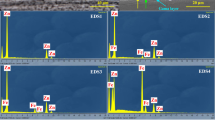Abstract
Material selection is an important task in the mechanical design of industrial components such as piping and valves. Industrial valves play a vital role in fluid control in the piping systems used in various industries, including the oil and gas industry. Low-alloy steel materials are widely used for subsea valves in size ranges of 3″ and above. In a recent subsea project that included 13 manifolds and 1056 valves, 34% of the subsea valves were made of low-alloy steel material, whereas 66% of them in size range less than 3″ were in super duplex. If the valve body is made from duplex stainless steel rather than low-alloy steel plus Inconel 625, the price of each valve could be 1.10–1.15 times higher than the unit prices in the following table. Since low-alloy steel is not a corrosion-resistant alloy (CRA), its extensive uses raises concerns about its application in the harsh and corrosive subsea environment, which is at the same time a precious and increasingly embattled ecosystem. The external corrosion of low-alloy steel body valves can be prevented by a combination of coating and cathodic protection. The internal corrosion of this material is prevented by applying 3 mm of Inconel 625 cladding in two layers. This article offers recommendations for future research, such as the application of low-alloy steel materials for other parts of subsea valves and the use of laser weld technology for applying an Inconel 625 weld overlay.





Similar content being viewed by others
References
Totten GE, Xie L, Funatani K (2003) Modeling and simulation for material selection and mechanical design, 1st edn. CRC Press. New York, USA
Ashby MF, Cebon D (1993) Material selection in mechanical design. J de physique Arch IV France 03. C7-1–C7–9. https://doi.org/10.1051/jp4:1993701
Nesbitt B (2007) Handbook of valves and actuators: Valves manual international, 1st edn. Elsevier, Oxford, UK
Skousen PL (2011) Valve handbook, 3rd edn. McGraw-Hill, USA
Smit P, Zappe RW (2004) Valve selection handbook, 5th edn. Elsevier, New York, NY
Sotoodeh, K. (2021). Safety and reliability improvements of valves and actuators for the offshore oil and gas industry through optimized design. University of Stavanger. PhD thesis UiS, No. 573
Sotoodeh K (2018) Analysis and improvement of material selection for process piping system in offshore industry. Am J Mechan Eng 6(1):17–26. https://doi.org/10.12691/ajme-6-1-3
Sotoodeh K (2018) Pipeline valves technology, material selection, welding, and stress Analysis (A case study of a 30 in class 1500 pipeline ball valve). Am Soc Mechan Eng (ASME), J Pressure Vessel Technol 140(4): 044001, https://doi.org/10.1115/1.4040139. Paper No. PVT-18–1043
Sotoodeh K (2019) A review on subsea process and valve technology. Marine Syst Ocean Technol 14:210–219. https://doi.org/10.1007/s40868-019-00061-4
Sotoodeh K (2020) Optimized material selection for subsea valves to prevent failure and improve reliability. J Life Cycle Reliab Safety Eng, Springer. https://doi.org/10.1007/s41872-020-00152-x
Sotoodeh K (2020) A review and analysis of industrial valve material failures due to corrosion and proposals for prevention measures based on industrial experiences in the offshore sector of the oil and gas industry. J Failure Analysis Prevent Springer. https://doi.org/10.1007/s11668-020-01064-9
Sotoodeh K (2020) Material selection for subsea valves. KCI Publishing Stainless Steel World Magazine 32:47–50
Ivanov H (2016) Corrosion protection systems in offshore structures. The University of Akron
Chandler KA (2014) Marine and offshore corrosion. Elsevier Science, Marine engineering series
Johnsen R, Barnoush A, Lannuzzi M (2017) Materials and corrosion trends in offshore and subsea oil and gas production. NPJ Mater Degrad. https://doi.org/10.1038/s41529-017-0003-4
Bai Y, Bai Q (2012) Subsea engineering handbook, 1st edn. Elsevier, Atlanta, GA, USA
Sotoodeh K (2021) Simulation of underwater conditions for subsea valves: A review of hyperbaric tests and validation. Int J Pressure Vessels Piping Elsevier. https://doi.org/10.1016/j.ijpvp.2021.104353
Sotoodeh K (2021) Subsea valves and actuators for the oil and gas industry, 1st edn. Gulf Professional Publishing, Austin, USA
Hansen SK (2016) Modelling failure mechanisms in subsea equipment. Norwegian University of Science and Technology
Det Norske Veritas (DNV) (2000) Subsea joint industry project (JIP). Hovik, Norway
Sotoodeh K (2021) HISC analysis for valves in subsea oil and gas industry. Safety Extreme Environm 3:1–8. https://doi.org/10.1007/s42797-021-00030-4
Sotoodeh K (2015) Axial flow nozzle check valves for pumps and compressors protection. Valve World Magazine 20(1):84–87
Saegusa S, Tsunogai U, Nakagawa F, Kaneko S (2006) Development of a multibottle gas-tight fluid sampler WHATS II for Japanese submersibles/ROVs. Blackwell Publishing Ltd Geofluids 6:234–240. https://doi.org/10.1111/j.1468-8123.2006.00143.x
Sotoodeh K (2019) Actuator sizing and selection. Springer Nature Appl Sci Springer Switzerland 1:1207. https://doi.org/10.1007/s42452-019-1248-z
American Petroleum Institute (API) 17H. Remotely operated tolls and interfaces on subsea production systems. 3rd edition. Washington DC. USA
Hale JR, Clegg WR (2001) Remotely operated, driverless subsea PIG launcher. Proceeding paper at the offshore technology conference. Houston Texas Paper Number OTC-13254-MS. https://doi.org/10.4043/13254-MS
Sun Q (2018) Quantitative study on the location selection of a subsea isolation valve of deep-water riser. Proceeding paper at the 28th International Ocean and Polar Engineering Conference. Sapporo, Japan. Paper Number: ISOPE-I-18-597
Thomas W (2017) Encyclopedia of maritime and offshore engineering. Wiley. ISBN: 9781118476352
Quale G, ArtunL, Lannuzzi M, Johnsen R (2017) Cathodic protection by distributed sacrificial anodes: A new cost-effective solution to prevent corrosion of subsea structures. Proceeding paper. Corrosion Conference, Orleans, Louisiana, USA. Paper number: NACE-2017–8941.
Abioye TE, McCartney DG, Clare AT (2015) Laser cladding of Inconel 625 wire for corrosion protection. J Mater Process Technol 217:232–240
Author information
Authors and Affiliations
Corresponding author
Additional information
Publisher's Note
Springer Nature remains neutral with regard to jurisdictional claims in published maps and institutional affiliations.
Rights and permissions
About this article
Cite this article
Sotoodeh, K. Case study of low-alloy steel material selection for the bodies of subsea valves: failure prevention approaches. Prog Addit Manuf 8, 77–85 (2023). https://doi.org/10.1007/s40964-022-00313-7
Received:
Accepted:
Published:
Issue Date:
DOI: https://doi.org/10.1007/s40964-022-00313-7




